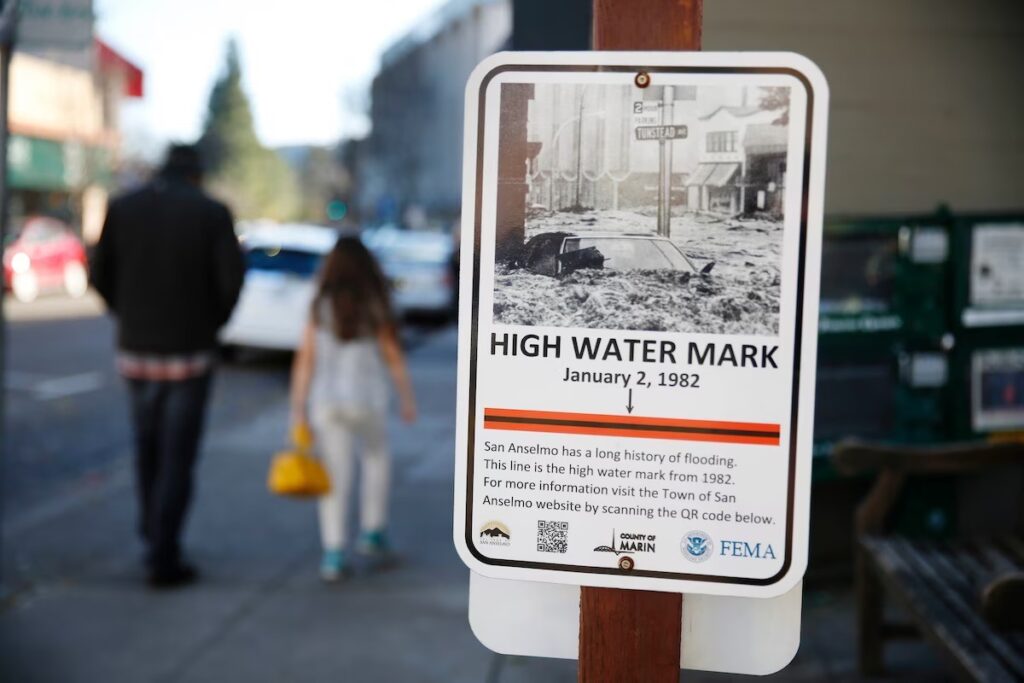
By Nicolás Rivero
12/13/23
Placards are displayed at an art installation titled “the Underwater” by Miami-Dade County artist-in-residence Xavier Cortada during Miami Art Week on Dec. 5. The initiative calls attention to the climate crisis through yard signs that reveal Miami’s vulnerability to rising seas. (Lynne Sladky/AP)
In Miami, a few inches can determine whether a building floods during high tides or heavy rains, a threat that is growing with climate change.
That’s why Xavier Cortada, a Miami-based artist and climate advocate, wants every resident to know how high above sea level their homes sit.
“The person across the street who asks you, ‘What’s that for?’ has a catalyst for a conversation for you to explain to them that both of you stand at four feet above sea level, and that the impact of a warming planet makes your homes vulnerable to all the issues that come with rising seas,” Cortada said.
He is part of a small group of artists, scientists and local officials trying to get people to think about climate change by illustrating the risk of flooding in everyday places, like their front yards. Computer scientists at the Mila-Quebec Artificial Intelligence Institute, a research collaboration between four Montreal universities, released a tool in 2021 that allows people to plug in their address and see what flooding would look like at their home.
“Often when we hear about climate change, we hear numbers like degrees of warming or parts per million, and that’s very abstract,” said Sasha Luccioni, an AI researcher who helped develop the tool. That’s why she and her colleagues “translated these abstract numbers into images that can really hit people close to home.”
After Hurricane Ike struck in 2008, Houston officials put up signs showing the height of a potential storm surge in the waterfront Clear Lake neighborhood.
“There’s tremendous value to these markers,” said Jim Blackburn, an environmental law professor at Rice University. “Warnings and information may be the most important tool that we have” to protect people from climate risks.
warning signs
Flooding signs are nothing new. NOAA and the National Weather Service started a project in 2006 to place “high water mark” signs around towns in the United States that had experienced severe flooding. The signs go on prominent buildings and landmarks, bearing the date of a historical flood and marking the level where the water reached.

A sign along San Anselmo Avenue indicates the high water mark reached in 1982 in San Anselmo, Calif., in 2017. (Lea Suzuki/San Francisco Chronicle/AP)
Residents in any community can request signs from the program. So far, participants have put up signs commemorating floods in 76 towns across 17 states. A similar FEMA-led program has placed high water mark signs in 37 cities since 2012.
These reminders of past extreme floods are becoming more relevant as sea levels rise higher and intense rainstorms become more common. But warning signs can also be controversial.
After Ike flooded Houston, city leaders placed 25-foot-tall signs in Clear Lake showing how high the water might rise in a Category 4 or Category 5 storm. Neighbors complained the signs would lower their property values, and the city removed them months later.
underwater homeowners
Cortada’s signs are meant, in part, to evoke the “for sale” signs that dot many Miamians lawns. In keeping with the real estate theme, he has also staged “Underwater Homeowners Association” meetings, in which scientists, engineers and insurance experts tell residents about the impact rising seas may have on their homes.

A sign along San Anselmo Avenue indicates the high water mark reached in 1982 in San Anselmo, Calif., in 2017. (Lea Suzuki/San Francisco Chronicle/AP)
Cortada doesn’t shy away from the connection between his signs and property values. He says that’s the point he’s trying to highlight.
So far, residents have been receptive. Cortada has enlisted thousands of people to look up their property’s elevation and make yard signs since he began the project, dubbed “the Underwater,” in 2018. Last week, Cortada recruited hundreds more, targeting areas such as Miami Beach and Wynwood which are thronged with visitors during Miami Art Week. He also toured schools to invite teenagers to bring their handmade signs home.
Katharine Mach, a climate scientist at University of Miami who has participated in Cortada’s Underwater Homeowners Association meetings, said the work gets people to think about climate change in a way government reports and academic papers can’t.
“When he does art as a social practice, it captures the heart and the mind in a way that is going to be different than an academic who’s presenting research on the exact same topic,” said Mach, who has written chapters for Intergovernmental Panel on Climate Change reports.
Cortada says he’s seen signs with elevation numbers as low as one foot above sea level, but he’s never seen someone write a number higher than 17. The majority of Miami-Dade County is six feet or less above the ocean. By 2100, the Southeast Florida Regional Climate Compact projects that local sea levels will rise somewhere between two and eight feet.
Cortada’s next project anticipates that future. This year, he began placing elevation markers in all of Miami-Dade County’s 287 parks. The sculptures are made from sustainable concrete designed to withstand seawater.
“In time those sculptures will be underwater, so I’m creating it for not just humans but for fish in the future,” he said.
Read the full story at https://www.washingtonpost.com/climate-solutions/2023/12/13/xavier-cortada-the-underwater/